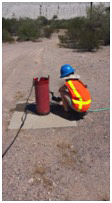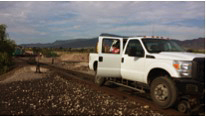I was honored and humbled to be the 2015 recipient of the Leonard Halpenny Intern Scholarship. I had the privilege of going to two consulting firms, one local municipal water company, and one federal agency. The following is an account of the time spent at each place. — Rachel Tucci
My first appointment took me to Montgomery & Associates, where I worked for Mr. Gary Woodard. I appreciated Mr. Woodard’s patience and advice as I began this new venture. Everyone was welcoming and kind. I assisted project manager Mr. Woodard on a project they were in the final phases of. I was tasked with making graphs that helped analyze the large data sets and brought answers to their desired questions. Mr. Woodard introduced me to author Edward R. Tufte to start thinking about how to display data in a more visually interesting way rather than just typical Excel charts. I enjoyed the working atmosphere of the office and appreciated this ideal opportunity as a way to start my summer internship low.
 My next destination was Clear Creek Associates, where I worked for Mr. Greg Hess. I gained valuable field experience by accompanying one of their field techs to sample wells at a client’s sites. This was my first sampling experience where we hooked up a generator to the pump on the well. We took depth-to-groundwater readings, field parameters, and water quality samples. I also gained excellent experience in the office. My first task was to compare hydrographs from pressure transducers and written sounder logs to identify where the pressure transducer data may have been inaccurate. The next task was to collect aquifer data from well logs and use AQTESOLV to run a sensitivity analysis to predict the behavior of a new aquifer-pumping test. The question to answer was: “How long does the pumping well need to run before we can see a response in the monitoring well?” The last task was using water chemistry data in AquaChem to see if there is a connection between groundwater and surface water. I made a Piper diagram with the data for cations (sodium, magnesium, and calcium) and anions (sulfate, bicarbonate, and chloride). Conclusions were based on well site proximity and whether the well was completed in shallow alluvium or bedrock. We also analyzed different constituents like copper, sulfate, manganese, and TDS within the water as it moved downstream to see where contributing influences might occur. Mr. Hess and his staff were encouraging and made the experience educational, fun, and unforgettable.
My next destination was Clear Creek Associates, where I worked for Mr. Greg Hess. I gained valuable field experience by accompanying one of their field techs to sample wells at a client’s sites. This was my first sampling experience where we hooked up a generator to the pump on the well. We took depth-to-groundwater readings, field parameters, and water quality samples. I also gained excellent experience in the office. My first task was to compare hydrographs from pressure transducers and written sounder logs to identify where the pressure transducer data may have been inaccurate. The next task was to collect aquifer data from well logs and use AQTESOLV to run a sensitivity analysis to predict the behavior of a new aquifer-pumping test. The question to answer was: “How long does the pumping well need to run before we can see a response in the monitoring well?” The last task was using water chemistry data in AquaChem to see if there is a connection between groundwater and surface water. I made a Piper diagram with the data for cations (sodium, magnesium, and calcium) and anions (sulfate, bicarbonate, and chloride). Conclusions were based on well site proximity and whether the well was completed in shallow alluvium or bedrock. We also analyzed different constituents like copper, sulfate, manganese, and TDS within the water as it moved downstream to see where contributing influences might occur. Mr. Hess and his staff were encouraging and made the experience educational, fun, and unforgettable.
 On to the USGS! What a wonderful adventure and learning experience. For the first half, I assisted two lead hydrologists — Ms. Kimberly Beisner and Mr. Nicholas Paretti — in the field on a project along the Verde River northwest of Cottonwood. Ms. Beisner taught me how to take water samples from a piezometer using a hand pump. The samples were analyzed for noble gases, radon, and stable isotopes.
On to the USGS! What a wonderful adventure and learning experience. For the first half, I assisted two lead hydrologists — Ms. Kimberly Beisner and Mr. Nicholas Paretti — in the field on a project along the Verde River northwest of Cottonwood. Ms. Beisner taught me how to take water samples from a piezometer using a hand pump. The samples were analyzed for noble gases, radon, and stable isotopes. We sampled a few springs, the Verde River, and a tributary to the Verde, Sycamore Creek. Mr. Paretti gave me an opportunity to use a flow meter to record stream discharge. One of my favorite aspects was acknowledging the importance of the geology in the area. We took a road-rail truck on the railroad tracks to the first sample site, which drove past four different geologic formations and different geological structures. I also had the opportunity to go in and work in the office with precipitation data. I synthesized a data set to create scatter plot graphs for analysis. As I move forward toward my master’s degree, this has been a valuable experience for my own research project.
We sampled a few springs, the Verde River, and a tributary to the Verde, Sycamore Creek. Mr. Paretti gave me an opportunity to use a flow meter to record stream discharge. One of my favorite aspects was acknowledging the importance of the geology in the area. We took a road-rail truck on the railroad tracks to the first sample site, which drove past four different geologic formations and different geological structures. I also had the opportunity to go in and work in the office with precipitation data. I synthesized a data set to create scatter plot graphs for analysis. As I move forward toward my master’s degree, this has been a valuable experience for my own research project.
 On my first day at Tucson Water, I was given a personal tour of their Sweetwater Recharge Facilities by senior hydrologist Dick Thompson. I was also invited to sit in on a meeting concerning new well locations and maintaining the existing wells. I was very impressed by how motivated the management staff is to continue sustainable and cutting-edge practices in regards to their municipal water distribution system. Mr. Thompson gave me the opportunity to go into the field with their engineering technical team. We went out to the Avra Valley recharge basins and I assisted with the collection of water quality samples and depth-to-water readings with a sounder at the designated wells. Another time we went out to verify that the data loggers were operating correctly by taking sounder readings. We also recorded depths of water in all the Avra Valley Complex basins from the staff gages and monitoring pumping house. I was shown different data loggers and how they function at three different mid-town Tucson well sites. The staff was very knowledgeable, helpful and explained how they do their job with respect and pride. I enjoyed each time I was given the opportunity to go into the field and learn.
On my first day at Tucson Water, I was given a personal tour of their Sweetwater Recharge Facilities by senior hydrologist Dick Thompson. I was also invited to sit in on a meeting concerning new well locations and maintaining the existing wells. I was very impressed by how motivated the management staff is to continue sustainable and cutting-edge practices in regards to their municipal water distribution system. Mr. Thompson gave me the opportunity to go into the field with their engineering technical team. We went out to the Avra Valley recharge basins and I assisted with the collection of water quality samples and depth-to-water readings with a sounder at the designated wells. Another time we went out to verify that the data loggers were operating correctly by taking sounder readings. We also recorded depths of water in all the Avra Valley Complex basins from the staff gages and monitoring pumping house. I was shown different data loggers and how they function at three different mid-town Tucson well sites. The staff was very knowledgeable, helpful and explained how they do their job with respect and pride. I enjoyed each time I was given the opportunity to go into the field and learn.
In conclusion, the Halpenny Intern Scholarship is designed perfectly, from the variety of companies / organizations to the length of time spent at each one to the hands on experience. Upon graduation, I was unclear what I should do next. This opportunity was just what I needed to make the decision to further my education as a hydrology graduate student at the master’s degree level.
I would like to extend a special thank you to all the companies and their staff. I was warmly welcomed at each place and treated with genuine respect. I went into this experience with passion and determination to help wherever needed. What I did not expect was the sincere concern for how they could help me. I heard over and over, “I want you to experience XYZ so when you leave you will have another tool for your toolbox.” I am overwhelmed with gratitude to the scholarship committee for awarding me this incredible, invaluable opportunity. I have had a wonderful time. Thank you!